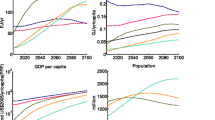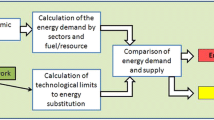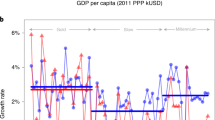Abstract
We investigate the extent to which future energy transformation pathways meeting ambitious climate change mitigation targets depend on assumptions about economic growth and fossil fuel availability. The analysis synthesizes results from the RoSE multi-model study aiming to identify robust and sensitive features of mitigation pathways under these inherently uncertain drivers of energy and emissions developments. Based on an integrated assessment model comparison exercise, we show that economic growth and fossil resource assumptions substantially affect baseline developments, but in no case they lead to the significant greenhouse gas emission reduction that would be needed to achieve long-term climate targets without dedicated climate policy. The influence of economic growth and fossil resource assumptions on climate mitigation pathways is relatively small due to overriding requirements imposed by long-term climate targets. While baseline assumptions can have substantial effects on mitigation costs and carbon prices, we find that the effects of model differences and the stringency of the climate target are larger compared to that of baseline assumptions. We conclude that inherent uncertainties about socio-economic determinants like economic growth and fossil resource availability can be effectively dealt with in the assessment of mitigation pathways.





Similar content being viewed by others
Notes
The RoSE project has been conducted over the period 2010–2013 using model versions as of 2010. Updated versions of each model have been developed since then, and are documented at the following websites. GCAM: http://wiki.umd.edu/gcam. REMIND: http://pik-potsdam.de/research/sustainable-solutions/models/remind and https://wiki.ucl.ac.uk/display/ADVIAM/REMIND. WITCH, http://doc.witchmodel.org/ and https://wiki.ucl.ac.uk/display/ADVIAM/WITCH IPAC: http://www.ipac-model.org.
Since then, the UN population projections have increased and no longer project a population peak in the 21st century. The UN 2015 revision gives a medium estimate of 11.2 billion people by 2100.
The AR5 scenario database contained 228 baseline scenarios to 2100, including the RoSE scenarios of GCAM, REMIND, and WITCH.
IPAC did not report carbon prices and mitigation costs in the RoSE study.
Near term carbon prices may be affected by additional energy policy assumptions and choice of model time steps, while long term prices can be affected by different ways on how to implement the forcing target (exponentially increasing carbon prices to meet a carbon budget vs. saturating price trajectories once the forcing target is approached).
The FS Gr SL Conv and the HI Gas scenarios were excluded from the sensitivity analysis since they were not calculated by all models. Since they are intermediate cases, their inclusion is not expected to affect results significantly.
References
Bauer N, Baumstark L, Leimbach M (2012) The REMIND-R model: the role of renewables in the low-carbon transformation—first-best vs. second-best worlds. Clim Change 114:145–168
Bauer N, Mouratiadou I, Luderer G, et al (this issue) Global fossil energy markets and climate change mitigation – an analysis with REMIND. Clim Change. doi:10.1007/s10584-013-0901-6
Bosetti V, Carraro C, Galeotti M, et al (2006) WITCH: a world induced technical change hybrid model. Energy J 27 (Special Issue 2):13–38
Bosetti V, Carraro C, De Cian E, et al. (2009) The 2008 WITCH model: new model features and baseline. FEEM Working Paper 2009:085
Bosetti V, Marangoni G, Borgonovo E, et al. (2015) Sensitivity to energy technology costs: A multi-model comparison analysis. Energy Policy 80:244–263. doi:10.1016/j.enpol.2014.12.012
Clarke L, Jiang K, Akimoto K, et al. (2014) Assessing Transformation Pathways. In: Edenhofer O, Pichs-Madruga R, Sokona Y, et al. (eds) Climate Change 2014: Mitigation of Climate Change. Contribution of Working Group III to the Fifth Assessment Report of the Intergovernmental Panel on Climate Change. Cambridge University Press, Cambridge, United Kingdom and New York, NY, USA
Clarke L, Kyle P, Wise M, et al. (2008) CO2 emissions mitigation and technological advance: an updated analysis of advanced technology scenarios. PNNL Report. Pacific Northwest National Laboratory, Richland, WA
De Cian E, Sferra F, Tavoni M (this issue) The influence of economic growth, population, and fossil fuel scarcity on energy investments. Clim Change. doi:10.1007/s10584-013-0902-5
Edmonds J, Reilly JM (1985) Global energy: assessing the future. Oxford University Press, New York
Edmonds J, Wise M, Pitcher H, et al. (1997) An integrated assessment of climate change and the Accelerated Introduction of advanced energy technologies - an application of MiniCAM 1.0. Mitig Adapt Strateg Glob. Change 1:311–339. doi:10.1023/B:MITI.0000027386.34214.60
Gillingham K, Nordhaus WD, Anthoff D, et al. (2015) Modeling uncertainty in climate. A Multi-Model Comparison. Natl Bur Econ Res Work Pap Ser, Paper No. 21637. doi:10.3386/w21637
Grübler A, Johansson TB, Mundaca L, et al. (2012) Chapter 1 - Energy Primer. In: Global Energy Assessment - Toward a Sustainable Future. Cambridge University Press, Cambridge, UK and New York, NY, USA and the International Institute for Applied Systems Analysis, Laxenburg, Austria, pp. 99–150
Hawksworth J (2006) The world in 2050: How big will the major emerging market economies get and how can the OECD compete? Pricewaterhouse Coopers, London
IPCC (2014) Scenario Database of the 5th Assessment Report of Working Group III of the IPCC. Accessible at https://secure.iiasa.ac.at/web-apps/ene/AR5DB. See Krey et al., 2014b, Section 10, for a description of the database.
Jiang K, Masui T, Morita T, Matsuoka Y (2000) Long-term GHG emission scenarios of Asia-Pacific and the world. Tech Forcasting Soc Change 61(2–3):207–229
Krey V, Luderer G, Clarke L, Kriegler E (2014a) Getting from here to there – energy technology transformation pathways in the EMF27 scenarios. Clim Change 123:369–382. doi:10.1007/s10584-013-0947-5
Krey V, Masera O, Blanford G, et al (2014b) Annex II: Metrics & Methodology. In: Climate Change 2014: Mitigation of Climate Change. Contribution of Working Group III to the Fifth Assessment Report of the Intergovernmental Panel on Climate Change [Edenhofer, O., R. Pichs-Madruga, Y. Sokona, et al (eds.)]. Cambridge University Press, Cambridge, United Kingdom and New York, NY, USA.
Kriegler E, Petermann N, Krey V, et al (2015) Diagnostic indicators for integrated assessment models of climate policy. Technol Forecast Soc Change 90, Part A:45–61. doi:10.1016/j.techfore.2013.09.020
Kriegler E, Weyant JP, Blanford GJ, et al. (2014) The role of technology for achieving climate policy objectives: overview of the EMF 27 study on global technology and climate policy strategies. Clim Change 123:353–367. doi:10.1007/s10584-013-0953-7
Leimbach M, Bauer N, Baumstark L, Edenhofer O (2010) Mitigation costs in a globalized world: climate policy analysis with REMIND-R. Environ Model Assess 15:155–173. doi:10.1007/s10666-009-9204-8
Leimbach M, Kriegler E, Roming N, Schwanitz J (2016) Future growth patterns of world regions – A GDP scenario approach. Glob Environ Change. doi:10.1016/j.gloenvcha.2015.02.005
Luderer G, Bertram C, Calvin K, et al (this issue) Implications of weak near-term climate policies on long-term mitigation pathways. Clim Change. doi:10.1007/s10584-013-0899-9
Luderer G, Leimbach M, Bauer N, et al (2015) Description of the REMIND Model (Version 1.6) Available at SSRN: http://ssrn.com/abstract=2697070
Luderer G, Pietzcker RC, Bertram C, et al. (2013) Economic mitigation challenges: how further delay closes the door for achieving climate targets. Environ Res Lett 8:34033. doi:10.1088/1748-9326/8/3/034033
McJeon HC, Clarke L, Kyle P, et al. (2011) Technology interactions among low-carbon energy technologies: what can we learn from a large number of scenarios? Energy Econ 33:619–631. doi:10.1016/j.eneco.2010.10.007
Morita T, Nakicenovic N, Robinson J (2000) Overview of mitigation scenarios for global climate stabilization based on new IPCC emission scenarios (SRES). Environmental Economics and Policy Studies 3(2):65–88
Nakicenovic N, Alcamo J, Davis G, et al. (2000) Special report on emissions scenarios: A special report of Working Group III of the Intergovernmental Panel on climate. Cambridge University Press, Cambridge, UK, 570 pp
Nordhaus WD, Boyer J (2000) Warming the world: Economic models of global warming, 2000. MIT Press, Cambridge, MA
Northrop PJ, Chandler RE (2014) Quantifying sources of uncertainty in projections of future climate. J Clim 27:8793–8808
Paltsev S, Capros P (2013) Cost concepts for climate change mitigation. Climate Change Economics, 4(Supplement 1):1340003
Pietzcker RC, Ueckerdt F, Luderer L (2015) Improving the representation of wind and solar variability in IAMs. Poster presented at the 8th Annual Meeting of the Integrated Assessment Modeling Consortium. Accessible at http://www.globalchange.umd.edu/iamc/wp-content/uploads/2016/01/IAMC-meeting-Report-2015_Annex3_Posters_final.pdf
Riahi K, Dentener F, Gielen D, et al. (2012) Chapter 17: Energy Pathways for Sustainable development. In: Global Energy Assessment - Toward a Sustainable future. Cambridge University Press, Cambridge, UK, and New York, NY, USA, and the International Institute for Applied Systems Analysis, and Laxenburg, Austria, pp. 1203–1306
Riahi K, van Vuuren D, Kriegler E, et al (2016) The Shared Socioeconomic Pathways: An Overview. Global Environmental Change
Riahi K, Kriegler E, Johnson N, et al (2015) Locked into Copenhagen pledges - Implications of short-term emission targets for the cost and feasibility of long-term climate goals. Technol Forecast Soc Change 90, Part A:8–23. doi:10.1016/j.techfore.2013.09.016
Rogelj J, McCollum DL, O’Neill BC, et al. (2013b) 2020 emissions levels required to limit warming to below 2 °C. Nat Clim Chang 3:405–412. doi:10.1038/nclimate1758
Rogelj J, McCollum DL, Riahi K (2013b) The UN’s “Sustainable energy for all” initiative is compatible with a warming limit of 2 [deg]C. Nat Clim Chang 3:545–551
Rogner H-H, Aguilera RF, Archer CL, et al. (2012) Chapter 7: Energy Resources and Potentials. In: Zou J (ed) Global Energy Assessment - Toward a Sustainable future. Cambridge University Press, Cambridge, UK, and New York, NY, USA, and the International Institute for Applied Systems Analysis, Laxenburg, Austria, pp. 425–512
Saltelli A, Ratto M, Andres T, et al. (2008) Global sensitivity analysis: the Primer. Wiley, New York
United Nations, Department of Economic and Social Affairs, Population Division (2008). World Population Prospects: The 2008 Revision.
UNFCCC (2015) Paris Agreement. United Nations Treaty Collection. Chapter XXVII Environment. TREATIES-XXVII.7d.
Webster M, Sokolov A, Reilly J, et al. (2012) Analysis of climate policy targets under uncertainty. Clim Change 112:569–583
Weyant J, Davidson O, Dowlabathi H, et al. (1996) Integrated assessment of climate change: an overview and comparison of approaches and results. In: Bruce JP, Lee H, Haites EF (eds) Climate Change 1995: Economic and Social Dimensions - Contribution of Working Group III to the Second Assessment Report of the IPCC. Cambridge University Press, Cambridge, United Kingdom and New York, NY, USA. pp. 371-396
Acknowledgments
The RoSE project, this work and the additional studies presented in the RoSE special issue were supported by Stiftung Mercator. RJB acknowledges support from the German-American Fulbright Foundation while at PIK.
Author information
Authors and Affiliations
Corresponding author
Additional information
This article is part of a Special Issue on “The Impact of Economic Growth and Fossil Fuel Availability on Climate Protection” with Guest Editors Elmar Kriegler, Ioanna Mouratiadou, Gunnar Luderer, Jae Edmonds, and Ottmar Edenhofer
Rights and permissions
About this article
Cite this article
Kriegler, E., Mouratiadou, I., Luderer, G. et al. Will economic growth and fossil fuel scarcity help or hinder climate stabilization?. Climatic Change 136, 7–22 (2016). https://doi.org/10.1007/s10584-016-1668-3
Received:
Accepted:
Published:
Issue Date:
DOI: https://doi.org/10.1007/s10584-016-1668-3




